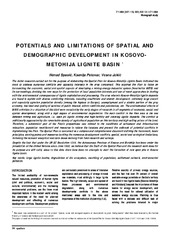Prikaz osnovnih podataka o dokumentu
Potentials and limitations of spatial and demographic development in Kosovo-Metohija lignite basin
| dc.creator | Spasić, Nenad | |
| dc.creator | Petovar, Ksenija | |
| dc.creator | Jokić, Vesna | |
| dc.date.accessioned | 2018-12-26T10:55:37Z | |
| dc.date.available | 2018-12-26T10:55:37Z | |
| dc.date.issued | 2009 | |
| dc.identifier.issn | 1450-569X | |
| dc.identifier.uri | https://raumplan.iaus.ac.rs/handle/123456789/152 | |
| dc.description.abstract | The initial research carried out for the purpose of elaborating the Spatial Plan for Kosovo-Metohija Lignite Basin indicated the need to address numerous conflicts and opposing interests in the area concerned. This required the Plan to focus on harmonizing the economic, social and spatial aspects of developing a mining-energy-industrial system (hereinafter MEIS) and its surroundings, devising the new ways for the protection of local population interests and use of novel approaches in dealing with the environmental consequences of lignite exploitation and processing. The area wherein Kosovo-Metohija lignite deposits are found is replete with diverse conflicting interests, including insufficient and uneven development, extremely large overall and especially agrarian population density (among the highest in Europe), unemployment and a sizable portion of the grey economy, low level and quality of services of public interest, ethnic conflicts and polarization, etc. The environmental effects of MEIS activities in a situation of this kind were revealed by the early stages of research in all segments of economic, social and spatial development, along with a high degree of environmental degradation. The main conflict in the Plan area is the one between mining and agriculture, i.e. open pit lignite mining and high-fertility soil covering lignite deposits. The conflict is additionally aggravated by the remarkable density of agricultural population on this territory and high selling prices of the land. Therefore, a substantial part of the Plan's propositions was related to the conditions of settlement and infrastructure relocation, population resettlement and measures to relieve the tensions and prevent the outbreak of potential conflicts in implementing the Plan. The Spatial Plan is conceived as a complex and comprehensive document defining the framework, basic principles, starting points and measures tackling the numerous development conflicts, spatial, social and ecological limitations, including the relevant analytical and data bases deriving from field research and surveys. Despite the fact that under the UN SC Resolution 1244, the Autonomous Province of Kosovo and Metohija has been under the jurisdiction of the United Nations since June 1999, we believe that the Draft of the Spatial Plan and the research work done for its purpose are still valid, since to this date there have been no attempts to start the formation of new open pits in Kosovo lignite basin. | en |
| dc.publisher | Institute of Architecture, Urban & Spatial Planning of Serbia | |
| dc.rights | openAccess | |
| dc.rights.uri | https://creativecommons.org/licenses/by-nc-nd/4.0/ | |
| dc.source | Spatium | |
| dc.subject | large lignite basins | en |
| dc.subject | degradation of the ecosystem | en |
| dc.subject | resettling of population | en |
| dc.subject | settlement network | en |
| dc.subject | environmental pollution | en |
| dc.title | Potentials and limitations of spatial and demographic development in Kosovo-Metohija lignite basin | en |
| dc.type | contributionToPeriodical | |
| dc.rights.license | BY-NC-ND | |
| dcterms.abstract | Петовар, Ксенија; Спасић, Ненад; Јокић, Весна; | |
| dc.citation.issue | 19 | |
| dc.citation.spage | 30 | |
| dc.citation.epage | 50 | |
| dc.citation.other | (19): 30-50 | |
| dc.identifier.doi | 10.2298/SPAT0919030S | |
| dc.identifier.fulltext | https://raumplan.iaus.ac.rs//bitstream/id/1501/149.pdf | |
| dc.type.version | publishedVersion |

